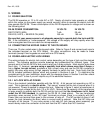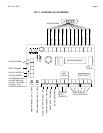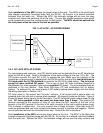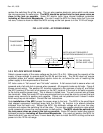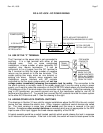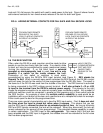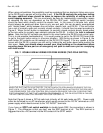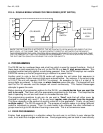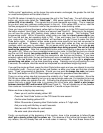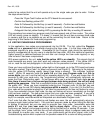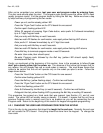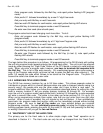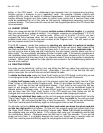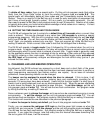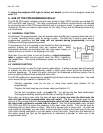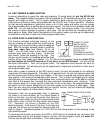Rev. A.2, 10/03 Page-11
"traffic control" applications, as the longer the code remains unchanged, the greater the risk that
an unauthorized person will be able to learn it.
The DK-26 makes it simple for you to program the unit in this “fixed” way. You will utilize a push
button set, single code called the “Hard code”. With power applied to the unit, note that the
yellow LED is on steadily. This signals that all code memories are empty. This is important
as you don’t want any unknown codes present in the unit. If the yellow LED is not on, read the
last two paragraphs in this section now for the procedure to erase existing codes.
Once you have confirmed the steady yellow light on the keypad, go to the CPU board and press
the button marked “Hard Code” for about one second (see Figure 2). Returning to the keypad,
you will see the yellow LED flashing slowly (about once per second). This indicates “hard
programming mode”. Within 30 seconds, simply enter your code from two to seven digits (you
can’t use the bell key but repeating digits is OK). If you wait longer than 30 seconds to start
your code entry, the “programming window” will terminate and you’ll have to press the Hard
Code button again. In general, longer codes provide more security but are less convenient to
remember and enter. However, many users like seven digit codes as they can be phone
numbers, which are easy to remember. Do not pause while you’re entering the code as any
time there is more than a five second gap between keys being pressed, the unit will stop
reading the sequence. Note that a successful button press is echoed by a beep and a flash of
the green LED. When you have completed entering your code, hit the Bell key and you should
see the red LED display two pulses within a second. If you don’t hit the Bell key, your code
will be accepted anyway but it will take five seconds to see the two red flashes. If you have
selected a seven digit code, the two red flashes will occur immediately as the digit limit has been
reached. The two pulses signal that your code has been accepted. If you get a single one
second long red pulse, you’ve done something wrong. Pressing one key and waiting for over
5 seconds, for example, would be would be interpreted as a disallowed single digit code.
If you get the single red flash, press the Hard Code button again and you can attempt to re-enter
a successful code. Once you get the two red flashes, re-enter your code and the door should
open. “Fixed” programming is complete. Should you ever want to change the code, just press
the Hard Code button on the CPU board again and repeat the procedure described above.
There is a minor wiring step that increases the reliability of a “fixed” code installation. Since the
DK-26 has multiple code capability but you only require single code use, it’s important to be sure
that no other codes can operate the unit. Following the programming steps in this Section will
assure that only a single Hard code is in memory but to be extra sure, install a wire jumper
between terminal SRC and terminal UCD (see Figure 2). This will disable any of the possible
User codes so if somehow one was programmed in, it would not open the door.
Below we show a step by step summary.
Power up unit; confirm steady yellow LED
Press the “Hard Code” button on the CPU board for one second
Confirm slow flashing yellow LED
Within 30 seconds of pressing Hard Code button, enter a 2-7 digit code
End your entry with Bell key or wait 5 seconds
Note two red LED flashes for confirmation
Re-enter code (door should open)
Finally, as mentioned at the beginning of this section, here is the procedure to follow if you
don’t get a steady yellow light on power up. The absence of the yellow light means that for
any reason, the unit already has one or more codes in memory. You must erase these other



